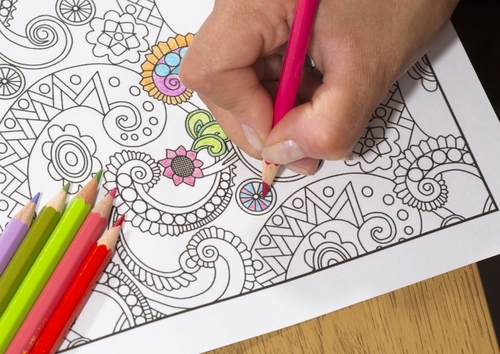Can They Play a Role in Therapy and Recovery?
So, what’s behind the coloring craze? Many people feel that coloring has stress-relieving qualities and helps to facilitate the practice of mindfulness. Some even consider them to be “therapeutic,” but behavioral health professionals caution against chalking them up as “art therapy.”
Jennifer Noto, The Meadows primary Expressive Arts Therapist, says that although coloring is no substitute for therapy, it can be a useful tool to help patients self-regulate and focus. We asked her to share some of her insights into coloring, its therapeutic properties, and its relationship to Expressive Arts Therapy.
What is Expressive Arts Therapy?
Expressive arts therapy (EAT) is defined as “the use of [visual] art, music, dance/movement, drama, poetry/creative writing, play and sandtray within the context of psychotherapy, counseling, rehabilitation or health care. (Source: Malchiodi, C. (ed.) (2005). Expressive Therapies. New York, NY: Guilford Press.)
The overarching goals of our Expressive Arts Therapy program at The Meadows Ranch are to externalize emotions and thoughts for deeper self-reflection, challenge perfectionism, and learn appropriate spontaneity. There are usually more specific goals in sessions such as trauma resolution and resolving core issues.
What are some ways that we use expressive arts therapy at The Meadows? Does coloring play a role?
At all of our programs—The Meadows, Gentle Path at The Meadows, the Claudia Black Young Adult Center and The Meadows Ranch—we encourage patients to create spontaneous art based on themes that we use in group sessions. Themes may include: emotions, boundaries, positive and challenging childhood memories, cultivating safety, identifying personal strengths, cultivating body awareness, working with control issues, etc. Patients use a variety of art materials such as drawing, painting, sculpting or working with found-objects to create the art.
For example, in one of our weekly group Expressive Arts Therapy sessions, I present a theme and everyone works on projects related to that theme unless it’s not a good fit for them. What’s so interesting about art therapy, though, is that usually what the person needs to work on that day is what comes up, regardless of the theme or project.
Let’s say we’re doing a project where I’m having patients paint masks and I’ve asked them to let the outside of the mask represent their outside selves (how they present to the world), and let the inside represent who they really are inside. For some patients, this may be just the right project at just the right time. But, if a patient is in their final week of treatment they may no longer find it useful to go back and look at how they were presenting to the world before treatment. So, they may use the mask project to instead look at their authentic self versus their addict self. There’s always room for someone to interpret the project in their own way. And if the project doesn’t work for them at all, I’ll just give them something else.
We seldom do anything coloring related, since the process of creating one’s own imagery is significant to gaining personal insights.
Why do you think adult coloring books have suddenly become so popular?
Well, we’ve had the Mandala coloring books at The Meadows for some time now—at least in the four years since I’ve been here—so it’s not entirely new to us. Even before they became bestsellers, we would have patients sitting and coloring in group therapy sessions. Many of the primary therapists would encourage them to do that because it helped them focus and self-regulate. The main difference in the coloring books that are popular now is that the designs are more elaborate.
A few months ago, in early February or March, I noticed that patients started showing up with the latest coloring books, like The Secret Garden. They’d say things like, “Oh, my mom sent me this and it’s really helping me.” I thought it seemed like a great tool to help patients focus and relax.
I wonder if they’re so popular in the public now because there’s generally more awareness about self-care and mindfulness and people see coloring as an outlet. People are probably also drawn to it because they know they can do it without having the pressure of creating something from scratch. I think it’s just a smart way of doing mindful work.
Coloring has been labeled as “therapeutic.” What’s the difference between therapy and an activity that is therapeutic?
There is definitely a difference between therapy and therapeutic activities. For example, coloring can help calm someone down in the moment, getting them more present and ready to do therapy and address their issues. If someone has childhood trauma, coloring may relax them for a time and teach them a healthier coping skill for distress. But, it won’t resolve underlying core issues, core messages and nervous system dysregulation.
I definitely think coloring can be therapeutic and healthy for many people. Any mindful activity that doesn’t have negative consequences, and is done in moderation, can help a patient feel more calm and centered.
For what types of conditions or issues could coloring possibly help?
I believe coloring could be helpful with patients suffering from anxiety, depression or Attention Deficit Disorder (ADD). It could be calming for those with anxiety, enlivening for those with depression (working with colors; focusing on enjoyable imagery), and it could help those with ADD focus their attention.
Are there times when Expressive Arts Therapy would not appropriate for a patient?
Since Expressive Arts Therapy is so diverse and can include music, movement, play and drama, there is usually something that every patient will connect with. Many patients enter the art room with fear and a bias that they aren’t creative and leave the session with a sense of empowerment and playfulness. I have even had patients who have art-related trauma (i.e., their abuser was an artist, or they were sexually assaulted at art school) who end up finding the process helpful, because they are able to renegotiate their relationship with art and reduce traumatic responses. There are a small handful of people who come in with a dislike of art and leave with the same perception, yet even for these patients, I think the process of trying something new is significant, and therefore, not contraindicated.
I like to read the energy of the room before assigning a theme or project in order to make appropriate modifications. For example, if I’m with a group of patients from The Meadows Ranch, and I can tell that they’re feeling kind of frustrated about meals, or are having a hard morning, or are feeling rushed, I’ll think, “Okay, they just need to play today.” So, instead of asking them to take on a childhood trauma that day I may ask them to just pick their medium and topic of choice and see where it takes them.
How does Expressive Arts Therapy fit into the overall Meadows Model for treating patients?
At The Meadows, our patients are at a point in life where they need a full regime of therapies and approaches to combat their trauma and addiction problems. The Meadows Model is an important part of the work I do in the art room. I’m also a Somatic Experiencing® Practitioner and incorporate this viewpoint into my approach. I think it’s important to have an understanding of the core issues as well as how trauma impacts physiology when working with any patient in any approach.
Expressive Arts Therapy is so fabulous because it can work with any type of treatment! Patients will often share their art projects with their primary group or in an individual trauma session. We work closely as a team at The Meadows and feed off the work each counselor is doing with a particular patient. For example, a patient may create artwork of a “safe place” in group with me, and then take that for use in their EMDR session. Expressive Arts Therapy also works well with the 12-step approach, as we can explore topics of acceptance, surrender, courage, and consequences of addiction.
Individualized Treatment to Fit Your Needs
Whether it’s Expressive Arts Therapy, Equine-Assisted Therapy, or 12-step, The Meadows programs can find the right combination to help you get on track and stay on track with your recovery. Call us today for more information.

